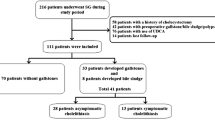Abstract
Background
Risk factors for gallstone formation in the general population have been well studied while those after weight reduction surgery are unknown. The aim of this study was to identify the risk factors for the development of symptomatic gallstones after bariatric surgery.
Method
Retrospective review was performed for patients who underwent laparoscopic Roux-en-Y gastric bypass (RYGBP), adjustable gastric banding (LAGB) or sleeve gastrectomy (LSG) between 2004 and 2006. Statistical evaluation was performed using a univariate and multivariate analysis. Risk factors, including age, gender, preoperative body mass index (BMI), BMI > 45 kg/m2, diabetes mellitus, hyperlipidemia, types of operation, and weight loss >25% of original weight, were analyzed for their association with postoperative symptomatic gallstones formation.
Results
670 laparoscopic RYGBP, 47 LAGB, and 79 LSG were performed in our institute. Preoperative gallbladder disease, as indicated by presence of gallstones or sludge on preoperative transabdominal ultrasound, or previous cholecystectomy, were found in 25.3, 14.9, and 30.4% of patients who subsequently had RYGBP, LAGB, and LSG, respectively. A total of 586 patients were included for analysis. Mean follow-up was 25.9 (range 12–42) months. Overall rate of symptomatic gallstone formation was 7.8% and mean time for its development was 10.2 (range 2–37) months. Incidence of symptomatic gallstones with complications as initial presentation was found in 1.9% of the patients. Logistic regression analysis showed that only postoperative weight loss of more than 25% of original weight was associated with symptomatic gallstones formation [B = 1.482, SE = 0.533, odds ratio 4.44, 95% confidence interval (CI) 1.549–12.498, p = 0.005].
Conclusions
Traditional risk factors for gallstone formation in the general population are not predictive of symptomatic gallstone formation after bariatric surgery. Weight loss of more than 25% of original weight was the only postoperative factor that can help selecting patients for postoperative ultrasound surveillance and subsequent cholecystectomy once gallstones were identified.
Similar content being viewed by others
References
Villegas L, Schneider B, Provost D, Chang C, Scott D, Sims T, Hill L, Hynan L, Jones D (2004) Is routine cholecystectomy required during laparoscopic gastric bypass? Obes Surg 14:206–211
Dhabuwala A, Cannan RJ, Stubbs RS (2000) Improvement in co-morbidities following weight loss from gastric bypass surgery. Obes Surg 10:428–435
Shiffman ML, Sugerman HJ, Kellum JM, Brewer WH, Moore EW (1991) Gallstone formation after rapid weight loss: a prospective study in patients undergoing gastric bypass surgery for treatment of morbid obesity. Am J Gastroenterol 86(8):1000–1005
Portenier DD, Grant JP, Blackwood HS, Pryor A, McMahon RL, Demaria E (2007) Expectant management of the asymptomatic gallbladder at Roux-en-Y gastric bypass. Surg Obes Relat Dis 3(4):476–479
Amaral JF, Thompson WR (1985) Gall bladder disease in the morbidly obese. Am J Surg 149:551–557
Scott DJ, Villegas L, Sims TL, Hamilton EC, Provost DA, Jones DB (2003) Intraoperative ultrasound and prophylactic ursodiol for gallstone prevention following laparoscopic gastric bypass. Surg Endosc 17(11):1796–1802
Miller K, Hell E, Lang B, Lengauer E (2003) Gallstone formation prophylaxis after gastric restrictive procedured for weight loss—a randomized double-blind placebo-controlled trial. Ann Surg 238(5):697–702
Pacchioni M, Nicoletti C, Caminiti M, Calori G, Curci V, Camisasca R, Pontiroli AE (2000) Association of obesity and type II diabetes mellitus as a risk factor for gallstones. Dig Dis Sci 45(10):2002–2006
Brandao Iglezias, de Oliveira C, Adami Chaim E, da Silva BB (2003) Impact of rapid weight reduction on risk of cholelithiasis after bariatric surgery. Obes Surg 13(4):625–628
Shiffman ML, Shamburek RD, Schwartz CC et al (1993) Gallbladder mucin, arachidonic acid, and bile lipids in patients who develop gallstones during weight reduction. Gastroenterology 105:1200–1208
Shiffman ML, Sugerman HJ, Kellum JH et al (1993) Gallstones in patients with morbid obesity Relationship to body weight, weight loss and gallbladder bile cholesterol solubility. Int J Obes Relat Metab Disord 17:153–158
Erlinger S (2000) Gallstones in obesity and weight loss. Eur J Gastroenterol Hepatol 12:1347–1352
Mason EE (2002) Gallbladder management in obesity surgery. Obes Surg 12:222–229
Kiewiet RM, Durian MF, van Leersum M, Hesp FL, van Vliet AC (2006) Gallstone formation after weight loss following gastric banding in morbidly obese Dutch patients. Obes Surg 16(5):592–596
O’Brien PE, Dixon JB (2003) A rational approach to cholelithiasis in bariatric surgery. Arch Surg 138:908–912
Ammori BJ, Vezakis A, Davides D, Martin IG, Larvin M, McMahon MJ (2001) laparoscopic cholecystectomy in morbidly obese patients. Surg Endosc 15(11):1136–1139
Diehl AK (1991) Epidemiology and natural history of gallstone disease. Gastroenterol Clin North Am 20:1–19
Mason EE (2002) Gallbladder management in obesity surgery. Obes Surg 12:222–229
Heaton KW, Braddon FEM, Mountford RA, Hughes AO, Emmett PM (1991) Symptomatic and silent gallstones in the community. Gut 32:316–320
Swartz DE, Felix EL (2005) Elective cholecystectomy after Roux-en-Y gastric bypass: why should asymptomatic gallstones be treated differently in morbidly obese patients? Surg Obes Relat Dis 1(6):555–560
Tucker O, Fajnwaks P, Escalante-Tattersfield T, Szomstein S, Rosenthal R (2007) Is concomitant cholecystectomy necessary in obese patients undergoing laparoscopic gastric bypass surgery? SAGES (abstract): 200
Yang H, Peterson GM, Roth MP, Schoenfield LJ, Marks JW (1992) Risk factors for gallstones formation during rapid loss of weight. Dig Dis Sci 37:912–918
Dhabuwala A, Cannan RJ, Stubbs RS (2000) Improvement in co-morbidities following weight loss from gastric bypass surgery. Obes Surg 10:428–435
Author information
Authors and Affiliations
Corresponding author
Additional information
Accepted as poster, SAGES 2008 and presented April, 10–12th.
An erratum to this article can be found at http://dx.doi.org/10.1007/s00464-009-0445-z
Rights and permissions
About this article
Cite this article
Li, V.K.M., Pulido, N., Fajnwaks, P. et al. Predictors of gallstone formation after bariatric surgery: a multivariate analysis of risk factors comparing gastric bypass, gastric banding, and sleeve gastrectomy. Surg Endosc 23, 1640–1644 (2009). https://doi.org/10.1007/s00464-008-0204-6
Received:
Revised:
Accepted:
Published:
Issue Date:
DOI: https://doi.org/10.1007/s00464-008-0204-6




